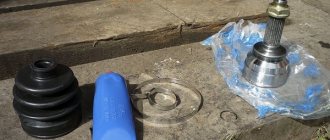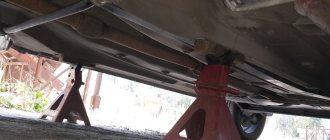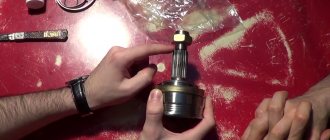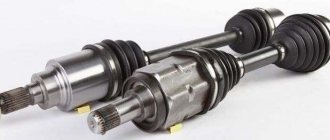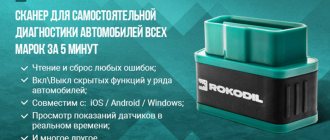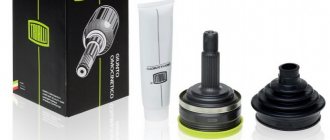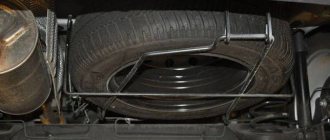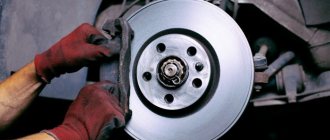Step-by-step algorithm for replacing a CV joint
The process should be started if there is complete confidence in the failure of the specified unit. Replacing the outer CV joint step by step if you do it yourself.
- We loosen the tightening of the wheel fasteners and the hub nut (first remove the cotter pin) on one of the sides of the car.
- We hang up this side with a jack and install stops under the wheels of the stern, and a safety support under the body.
- We completely remove the wheel.
- Unscrew the two bolts holding the ball joint to the steering knuckle bracket and the hub nut.
- We turn the steering wheel of the Lada Kalina as far as possible to the side, move the axle and remove the axle shaft from the splined engagement of the hinge and the hub. If there are difficulties with the free exit of the axle shaft, then use a hammer, applying impact forces to the shaft through a drift.
- When the axle shaft is released, we begin to dismantle the outer joint boot in combination with the clamps. These items must be replaced.
- Now we move on to removing the CV joint. To do this you will need a special puller. If it is missing, then use the hammer again. It is forbidden to apply an impact load to the separator, so we apply gentle blows to the body in an outward direction. The joint will come off if the retaining ring compresses, allowing the cage to slide off the axle shaft.
- When it is necessary to dismantle the entire axle shaft, the algorithm of actions up to point No. 7 is similar, and then, using a mount, we remove the shaft of the designated CV joint from engagement with the side gear in the transmission differential. Before such manipulation, drain the oil from the box. We take out the axle shaft as an assembly, after which we perform the necessary disassembly steps, etc.
- Removing the internal hinge involves the identical procedure given in point No. 7. To make disassembly easier, we use a vice in which we place and fix the structure.
Replacing a grenade on a Lada Kalina with your own hands
A constant velocity joint (CV joint) is a unit through which torque is transmitted from the transmission unit to the drive wheels. This device is also popularly called a “grenade”. There are both external CV joints, which directly engage the wheel hub, and an internal CV joint, which is adjacent to the gearbox. Both hinges on one side of the car are connected to each other by a metal pipe, and the entire structure is called an axle shaft. It happens that malfunctions appear, so many drivers are interested in how to change them.
The CV joint device is not particularly complicated. The unit includes a housing, a boot and a bearing, the separator of which is capable of rotating at different angles to the axle shaft, providing the ability to transmit rotation when the wheels are turned through the steering, therefore, using the tips, you can figure out on your own how to change the CV joint.
The video demonstrates the procedure for replacing the CV joint in the Lada Kalina chassis:
For models of domestic origin, including the Lada Kalina, failure of the hinge we are considering is a fairly common case. The most common factor causing the breakdown of this unit is a torn boot. This is due to the fact that dirt and moisture enter the working area of the hinge, eventually washing away the bearing lubricant, which causes wear and loss of functionality. And the outer CV joint needs to be replaced. You can do this procedure yourself.
Changing the CV joint on Kalina
The replacement of the outer CV joint itself, as well as if the inner CV joint is changed in the Lada Kalina, does not cause any particular difficulties for the owners. In order for the work to be completed correctly, you will need to use the following set of tools and auxiliary tools:
- socket heads with sizes “17” and “30”;
- knob with extension;
- ratchet;
- jack and anti-rolling stops;
- hammer, drift and vice.
Symptoms of a problem
The primary factor indicating the wear of the “guarantor” is a crunching sound when the LADA Kalina car begins to move intensively on the wheels with the steering wheel turned, and in this case the grenade needs to be replaced. If the hinge has significant wear or the separator is broken, then such a sound effect will occur even under insignificant loads. Further movement is unacceptable! Replacing the grenade is inevitable.
Hinge selection by brand
Here, the opinions of Lada Kalina owners are divided in terms of preference for a specific manufacturer. However, practice has shown that the following brands have the largest number of positive reviews: VIS, GNK and GLO.
Let's sum it up
Most CV joint kits sold by sellers in a specialized network of automotive products for LADA Kalina cars immediately include the required amount of lubricant and a boot with clamps. We recommend that you pay attention to this aspect in order to protect yourself from overpaying during the purchase.
Source: https://Vaz-Lada-Granta.com/kalina/podveska/shrus.html
CV joint Lada Granta
articles:
0:37
1. Replacement of the outer CV joint for the Lada Granta
0:115
2.: “Replacing the boot of the outer and inner CV joint (grenade)
0:240
In what cases is it necessary to replace the inner CV joint?
Replacing the internal CV joint on front-wheel drive VAZ vehicles is required if the following symptoms are present:
- Crunching and knocking noises when driving and accelerating in a straight line;
- Vibration and shock when changing gears;
- Significant play when testing by hand;
- If the “grenade” fails completely, the vehicle cannot move further. The main reason for the malfunction of the VAZ grenade is the entry of water and dirt through the hole in the torn boot. The second possible cause of failure is a sharp press on the gas with the wheels fully turned, although in this case you risk killing the external rather than the internal grenade.
In addition to the above, replacing the internal CV joint on VAZ-2110 and other models may be necessary if the quality of the previously installed joint is poor.
How to independently replace the internal grenade on VAZ cars
CV joint (constant velocity joint) is a mechanism that allows you to transmit torque between misaligned shafts. The device is actively used on front-wheel drive vehicles. On each shaft coming out of the gearbox there are two of them - internal and external. Repair is impossible; if the unit breaks down, it is replaced as an assembly.
- In what cases is it necessary to replace the inner CV joint?
- Replacing the inner CV joint with your own hands
- Boot replacement and repair
- CV joint repair
Assembly procedure step by step
We carry out the entire list of assembly operations in a Lada Kalina car in strictly reverse order. During the procedure, it is necessary to take into account some nuances.
- First, we put the boot on the axle shaft. If this is difficult, then its surface can be lubricated with the grease supplied with the new hinge kit.
- Now we fill the same grease into the CV joint bearing, and the remainder into the internal cavity of the boot.
- We install the hinge on the axle shaft. We also use a hammer, applying a shock load to the body. The retaining ring should be replaced.
- When the “grenade” “sits” in its place, we push the boot, after squeezing it with our hands to remove excess air. We install clamps.
- We do the same when replacing the internal hinge.
- Now we install the axle shaft into the transmission housing until the shaft engages with the side gear. Don’t forget to fill the unit with oil afterwards.
- We insert the outer joint into the steering knuckle until it fully engages with the splined race of the hub. Screw on the central nut (do not tighten it).
- We return the ball joint to its place.
- We hang the wheel and do not tighten its fasteners too much.
- We lower the car (we do not unload the jack completely). Tighten all fasteners to the required torques. We remove the jack and stops. Replacement of the outer CV joint is complete.
The owner of LADA Kalina will spend no more than 3 hours of his time to complete the full list of replacement actions. We check the correct installation of the hinges. To do this, we start driving the car with the wheels turned out as far as possible. We observe the absence of crunching and other characteristic sounds from the axle shaft. Now you know how to change a faulty CV joint.
What is needed to install a new CV joint
The CV joint, despite its strength, has parts that can wear out over time or if used incorrectly. Often, CV joint replacement occurs due to damage to the boots - during driving, cracks and holes appear that become clogged with dirt, water and dust. This way you can drive hundreds, or even thousands of kilometers, which will finally finish off the mechanism. Boot problems are expressed in a crackling sound when turning the wheels (when turning to the right, the left wheel cracks, when turning to the left, the right wheel cracks). Sometimes the CV joint has to be replaced due to incorrect actions by the driver. Acceleration of the engine with slipping, starting on the wheels turned out, braking by the transmission - often the cause of the malfunction lies in this.
Play in the ball joint has a negative effect on the CV joint. It occurs when the support itself is already severely worn out. If this problem is not identified in time, it will have a very negative impact on the CV joint. Thus, driving at high speed can tear out the support pin, which can cause the grenade to break.
It is extremely rare that CV joint failures are caused by factory defects in the mechanism parts or initially incorrect installation. Coupled with a worn boot, the problem can reach unimaginable proportions. Many reviews on automotive forums mentioned the poor quality of some parts - both basic functional elements and additional little things, like clamps.
Regardless of the source of the problem, a grenade that is not working properly will require replacement. Machine manufacturers claim that when parts wear out, the entire mechanism must be replaced, even those elements that were not damaged by failure. Considering the high quality of materials, the repair will cost quite a lot. In this regard, the car owner tries to replace the CV joint with his own hands. What will the driver need?
- pit or lift;
- hammer, screwdriver, pliers, jack;
- a set of keys or heads;
- bench vice;
- new clamps, lubricant (CV joint-4, for example), hub nut with stopper.
The latter (consumables) are often provided with a new grenade. All of the above are suitable for replacing outer and inner CV joints.
How does the part change?
To dismantle the old boot and install a new one, you will need an inspection hole or a lift. Obviously, such devices are not always available at home, so most often you have to use a jack.
Before starting the procedure, of course, you need to purchase a new boot. There is nothing better than the original part, but many modern manufacturers offer quite passable analogues. They often come with matching clamps.
You also need to stock up on the following ingredients and tools:
- lubricant;
- tripoid puller (if you don’t have one, you’ll have to use a hammer and chisel);
- wrenches 17 and 30 mm;
- hammer;
- pliers;
- screwdriver;
- metalworker's vice.
So, if everything is prepared, you can begin the procedure. Let's consider step by step how to replace the outer CV joint boot (the inner one is nearby, so replacing it is not a problem):
- remove the brake pads, caliper, wheel drive;
- press out the ball joint;
- remove the hub and brake disc;
- remove the CV joint drive;
- remove the retaining ring and tripoid.
Attention! If you do not want to complicate the installation of the tripoid after replacing the boot, you should immediately note its position on the shaft.
If there is no special puller, a hammer and chisel will do, but these tools must be used carefully so as not to damage the hinge and other elements of the car.
After dismantling the tripoid, it is worth removing the clamps and the boot itself. Then you need to remove all the old grease and wash the grenade. Virtually any degreasing composition is suitable for this. A simple example is gasoline. Now you can apply new lubricant, put on the purchased clamps and boot.
After this, you can assemble all the components in reverse order, and then check the result of the work.
The debate among drivers about which drive is better, front or rear, has been going on for several years now. The CV joint boot is an important mechanism, and its failure can lead to serious things. Let's look at the replacement process and cost.
Car enthusiasts often argue whether front-wheel drive or rear-wheel drive is better. Each has its own pros and cons. For example, rear-wheel drive cars have a more complex rear-wheel drive design and a rather simple front suspension. In a front-wheel drive car, everything is exactly the opposite, since all the complexity is on the front end.
Replacing the CV joint on the Lada Grant. Service life and causes of malfunctions of the “grenade”
In a car with front-wheel drive, it is not the driveshaft with the main gear and axle shafts that is responsible for transmitting torque from the gearbox to the wheels, but special parts - CV joints, they are also constant velocity joints, in common parlance - a “grenade”. They consist of a drive and a CV joint itself; there are 2 of them on each drive. – external (closer to the wheel) and internal (closer to the gearbox). The “Grenade” is very durable, and with constant maintenance the car can withstand 100,000 km. and more. However, it does not last forever, and one day it may fail. In this article we will talk about how to independently diagnose and replace an external CV joint using the example of the popular Russian car Lada Granta.
Causes of grenade malfunctions and its diagnosis
Usually the CV joint does not break right away. You will feel the car accelerate jerkily and hear a knocking sound from somewhere in the front suspension. Over time, symptoms worsen. Diagnostics is very simple: put the car on a jack and swing the CV joint of the suspended wheel. Do you feel any play? It's time to change the part.
There are 4 main reasons why CV joints fail prematurely:
1) The part itself is of low quality or defective;
2) The vehicle is operated off-road;
3) The boot has torn, and dust and abrasive particles have penetrated inside;
4) Aggressive driving style.
If you turn to specialists for help, you will have to fork out money. Replacement service costs an average of 1,500 rubles. for 1 CV joint.
You can save money by doing your own repairs: the cost of a spare part in auto shops starts from 1000 – 1500 rubles. for 1 “grenade”, complete with drive components cost about 3000 – 4000 rubles. There are a lot of manufacturers, but it is better to take the original from AvtoVAZ.
Tools and materials
- new CV joint (the grenade itself, without the drive) and lubricant for it;
- jack, hammer;
- wheel wrench, mounting, pipe of suitable diameter;
- a set of wrenches and sockets, a screwdriver;
- graphite lubricant.
Replacing CV joints (constant velocity joints) on a Lada Granta VAZ 2190
- Pliers
- Large flat screwdriver
- Small hammer
- Soft metal drift
- Vice with soft metal jaws
- Jack
- CV joint grease-4
- Wood spacer
- Constant velocity joints
- Front wheel drive shaft valve
- Rags
- Gloves
Replacing a CV joint or repairing it is a fairly common occurrence, the harbingers of which are knocking, crunching and crackling noises when turning the car’s wheels.
1. Remove the front wheel drive from the vehicle as described here or here.
2. Clamp the drive shaft in a vice with soft metal jaws.
3. Squeeze the bent antennae of the inner collar of the inner CV joint boot with pliers.
4. Squeeze the clamp lock of the inner CV joint boot with pliers.
6. Similarly, remove the outer clamp of the CV joint boot.
7. Slide the dirt boot over the shaft and turn it inside out.
8. Using a drift, knock the inner CV joint off the front wheel drive shaft, applying force to the CV joint cage.
9. Please note: a plastic buffer is installed at the inner end of the front wheel drive shaft.
10. Check for grease in the new CV joint. The CV joint should contain 80 cm3. SHRUS-4 lubricants.
11. When installing the CV joint, place it on the front wheel drive shaft with gentle hammer blows through a wooden spacer along the outer end of the shank along its axis until the hinge is fixed on the shaft. When installing the CV joint, make sure that no dirt gets into it.
12. Install the boot on the CV joint housing.
13. Install the outer and inner CV joint boot mounting clamps in the reverse order of removal.
14. If it is necessary to replace the boots, remove the CV joint from the front wheel drive shaft and remove the air release valve assembled with the casing from the boot, sliding the valve along the shaft. Remove the boot from the front wheel drive shaft.
15. To replace the valve, unscrew its casing and, having removed the valve from the casing, remove the valve from the front wheel drive shaft.
16. Then remove the valve cover from the front wheel drive shaft.
17. Install the valve and new CV joint boot in the reverse order of removal.
18. Having installed the CV joint, secure the boot with clamps.
19. To replace the outer CV joint, remove its outer and inner boot clamps in the same way as you did for the inner CV joint.
20. Slide the boot along the front wheel drive shaft and turn it inside out.
21. Using a drift, knock out the outer CV joint from the front wheel drive shaft, applying force to the CV joint cage.
22. Install an external CV joint on a Lada Granta VAZ 2190 car in the same way as installing an internal CV joint. The difference is that the outer CV joint needs to be filled with half as much (40 cm3) CV joint-4 lubricant as the inner CV joint.
- High-quality photos of repairs
- Photo of the instrument
- Photos of parts and consumables
Checking the condition of the CV joint
- External (external) CV joints - two pieces, located on the hubs, transmit torque to the wheels. The steering angle is significantly higher than that of an internal CV joint. They also take on more load. Accordingly, they break down more often and require regular inspection and replacement if necessary. They have a smaller size.
- There are two internal CV joints that make the axle shaft move; they are located in the gearbox, one on each side. They are larger in size. They are less subject to stress and, accordingly, can work longer.
You can assess the condition of the CV joint yourself. The easiest way to inspect the external one is to turn the steering wheel all the way (to the right or left) and quietly move away. If there is a problem, a cracking or crunching sound will appear. The more damage is done to the CV joint parts, the louder the sound will be.
If problems with the external grenade are accompanied by a crash when turning, then problems with the internal grenade are accompanied by a crack when moving straight. The sound will intensify if you drive off-road - every bump, hole or ditch will clearly remind you of the problem. If you notice a crunching sound, carry out repairs immediately - problems with the internal CV joint are very dangerous. It's a little more difficult to inspect:
- We put the car on the lift.
- We turn on first gear, the wheels should rotate slowly (the car should be slightly raised).
- The presence of a distinct crunching sound is evidence of problems.
If you hear a cracking sound while driving - when turning, when overcoming off-road obstacles, or sudden acceleration - immediately fix the problem. Timely inspection and repair will help the car owner remain a driver and not a pedestrian. In addition, a problem detected in time will help to avoid critical situations on the road.
Signs of failure of the outer grenade (CV joint).
There are two options here:
- signs that your grenade has already broken
- signs that the grenade will soon come out and break .
How to understand that a grenade will soon break.
Of course, the first sign of a malfunction of the external grenade is a crackling sound . If you hear a crackling noise while driving with the steering wheel turned, it is definitely a CV joint. The greater the angle of rotation of the wheel and the harder you press on the gas, the louder the clicks. Another sign that does not always appear is vibration on the steering wheel at speeds greater than 80 km/h. The vibration is only slightly similar to the vibration from an unbalanced wheel. It usually manifests itself as a slight twitching of the steering wheel.
How to understand that the outer CV joint has broken.
If the CV joint breaks, the car will stop moving. In any gear engaged, press the gas, the speed increases, but the car does not move.
How to understand that it is the outer CV joint that has broken, and not the internal one or the clutch in general (the first signs of failure are similar to the signs of a clutch failure)? First of all, start the car and put it in any gear. Next, open the hood and look in turn at each of the shafts going from the box to the wheels (one short, the other long). If any shaft is spinning, it means that the CV joint has broken on this side.
I recommend not just visually looking at the shaft, but touching it with some long, hard object, such as a stick. The main thing is that there is nothing on it that can wrap around the shaft !!! When you touch the shaft with a stick, if it is spinning, you will feel a slight vibration. This is usually done in the dark, because it is difficult to understand whether a cylindrical object is spinning, especially in the dark.
When to change the CV joint, signs of malfunction
As was said, the external grenade fails after about 40 thousand mileage. This is evidenced by crunching, creaking and knocking sounds in the area of the drive shafts. To determine which side of the CV joint requires replacement, you need to turn the steering wheel all the way and drive off. In 90% of cases, a worn drive will manifest itself as a crunching sound. For control, you can turn it first in one direction, and then in the other direction, and turn it back. If the CV joint is worn out, a crunching sound will be heard immediately.
New and worn CV joint
This is the case when there are no visual signs of wear:
- Lubricant leaks near the outer joint.
- Cracks, tears on the boot.
- Lost or misaligned clamps.
- There is obvious play when turning the suspended wheel.
If there are visual signs of wear, we replace the CV joint on the Grant as soon as possible.
CV joint repair
As mentioned above, the hinge cannot be repaired. Conventionally, one of the repair measures includes washing the “grenade” after driving with a damaged boot.
Washing is carried out at the same time when the damaged boot on the pomegranate is replaced. The hinge is carefully knocked off the shaft, inspected for damage and thoroughly washed to remove any dirt and grease in gasoline or kerosene.
Replacing the outer CV joint boot without removing it
This option eliminates the separation of the hinge and the shaft (if dismantling is not provided for by the design or there is a risk of destruction of parts). To carry out the procedure, you will need a special device that stretches the anther.
The time spent on repairs in this case is minimal, but be careful - there is a risk of damaging the elastic element.
The most difficult thing in such work is filling the internal cavity with lubricant.
Often car owners are faced with “sticking” to the hinge shaft. If the hub is held in place by a bolt, tighten it as much as possible to separate the parts. When the part rests against the axial end, make 3 additional turns (use a wrench). When fastening with nuts, you need to remove the axle shaft and clamp the drive in a vice. This fixation allows you to knock down the part with a chisel. If this fails, the not most convenient “home” option remains - cutting the ring with a grinder.
Removing the right front wheel drive (inner CV joint) Lada Granta
Tools:
- 17 mm straight box spanner
- Driver for socket attachment
- Extension for the end attachment on the wrench
- 8mm wrench attachment
- 10mm wrench attachment
- High nozzle on the wrench 13 mm
- 17mm wrench attachment
- 19mm wrench attachment
- 30mm wrench attachment
- Torx wrench attachment E12
- Large flat screwdriver or spatula
- Large hammer
- Kerner
- Funnel
- Hose
- Technological capacity
- Metal brush
- Jack or ditch lift
- Stand
- Adjustable stop
- Wheel key
Boot replacement and repair
The boot can be changed without removing the grenade if you have special equipment. His work is demonstrated on video. If you do not have such a device, to remove and replace it, you must perform the above procedure for removing the drive and dismantling the hinge. The procedure is necessary if there is even minor through damage on the boot.
Temporary repairs to the CV joint boot can be made without removing it from the vehicle. To do this, you need to thoroughly clean and degrease the damage, then seal it with a piece of rubber and cyanoacrylate-based glue (superglue).
An alternative repair method is to seal the holes with silicone caulk. It should be remembered that it takes a day to completely polymerize.
Note: express repair is a temporary measure. Replacing the inner joint boot may be delayed for a short time, but not completely cancelled. Typically, these types of repair methods are used to get to the point of repair.
Disassembling the hinge
An important diagnostic step is to inspect the CV joint boot. If it has visible damage, water or blockages have almost certainly penetrated inside.
In addition, it is necessary to completely disassemble the mechanism. To securely fix the part, you will need metalworker's cleats. After the outer CV joint housing is removed, all balls should be removed from the separator. This can be easily done with a screwdriver. It must be made of a sufficiently soft metal so that the surfaces of the parts are not damaged during operation.
Choosing an outer CV joint for the Lada Granta
There are enough hinges from different manufacturers on sale, it’s bad that sellers treat them like all Zhiguli spare parts - everything is the same. In practice, for the first generation Grants there are two types of external (and internal) CV joints - for cars with manual transmission and for Grants with automatic transmission. In a word, grenade 2215012-00 (21 teeth) .
For Lada Granta with a manual transmission there is a CV joint with catalog number 2215012-86 . In order not to be confused with numbers, let’s look at the differences between CV joints for Grants with automatic transmission and manual transmission:
- The spline connection in the outer hinge has changed in size, the number of teeth is 21 . A CV joint with 22 splines is suitable for a manual transmission.
- The geometric dimensions of the body have also been changed.
- The length of the outer spline part for manual transmission is 76.5 mm , for automatic transmission - 77 mm .
- height (without spline) 55 mm for automatic and 52.2 mm for manual .
- The number of teeth for the ABS ring does not change and remains 43.
Therefore, before purchasing an outer CV joint, we first look at the number of splines on the inside of the joint body. Among the manufacturers on the market, AvtoVAZ, Belmag and Triall dominate. The price of an outer CV joint on a Lada Granta is around $20.
It is important that the kit includes a locking ring, molybdenum disulfide-based lubricant and a neoprene boot. It should not be too hard, but a boot that is too thin will not last long.
Sources
- https://AutoManya.ru/kuplya-prodazha/vnutrennyaya-granata-granta.html
- https://kalina-2.ru/remont-vaz/zamena-vnutrennego-shrusa-lada-granta
- https://autodont.ru/running-gear/menyaem-shrus-samostoyatelno
- https://AVSU-pitanie.ru/info/lada-granta-zamena-shrusa-video/
- https://www.vaz-zona.ru/zamena-shrusa/
- https://granta-service.ru/prochee/zamena-pylnika-shrusa-vaz-2110-bez-snyatiya-shrusa-video-instruktsiya.html
- https://dtp-avarii.ru/kak-pomenjat-shrus-na-grante-video/
- https://zen.yandex.ru/media/uremont/zamena-pylnika-narujnego-shrusa—kak-zamenit-samomu-instrukciia-s-foto-5e907393f49321656d3e9dbc
CV joint Lada Granta | transmission gearbox clutch Lada Granta
1. Replacement of the outer CV joint for the Lada Granta
2. Video: “Replacing the boot of the outer and inner CV joint (grenade)
Replacement of outer CV joint for Lada Granta
Still, I decided to change the CV joint today. because then there will be no time. I made a photo report, as detailed as I could.
While the car is still with the wheel, loosen the hub nut using a 30mm socket and use a metal pipe for reinforcement.
